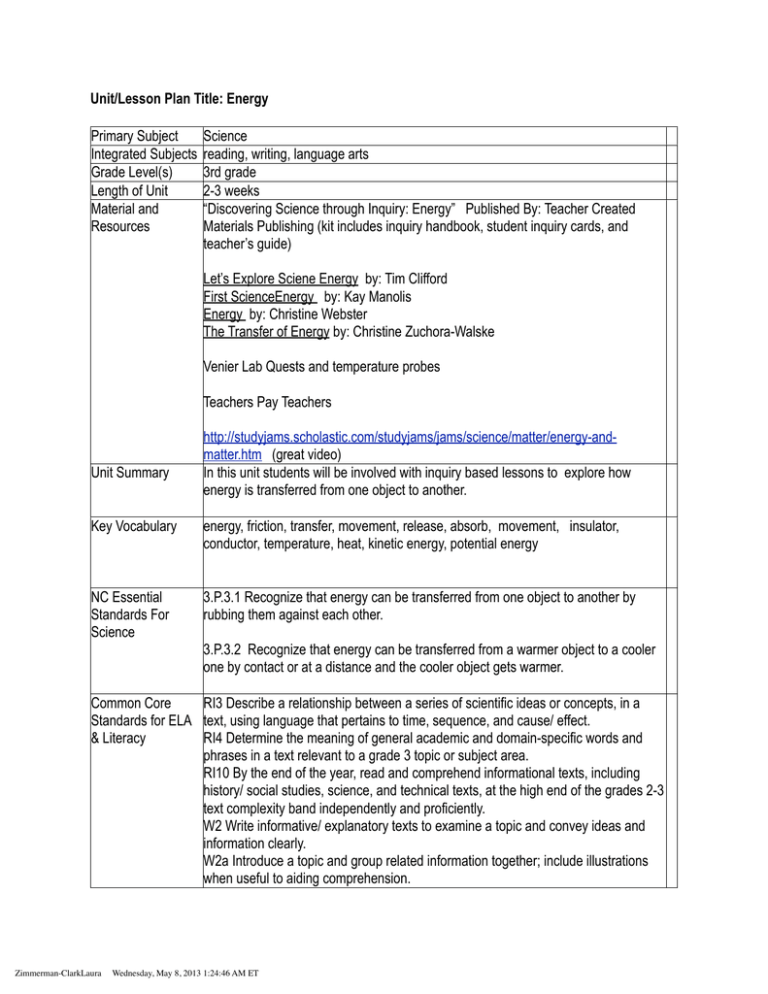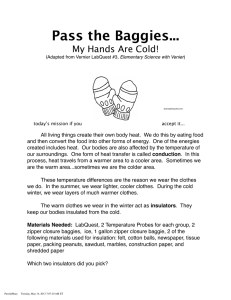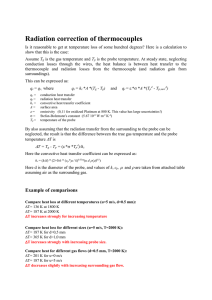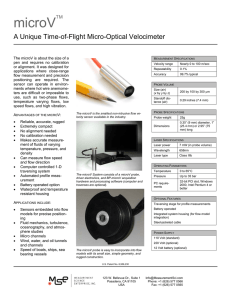Unit/Lesson Plan Title: Energy Primary Subject Science Integrated Subjects reading, writing, language arts
advertisement

Unit/Lesson Plan Title: Energy Primary Subject Integrated Subjects Grade Level(s) Length of Unit Material and Resources Science reading, writing, language arts 3rd grade 2-3 weeks “Discovering Science through Inquiry: Energy” Published By: Teacher Created Materials Publishing (kit includes inquiry handbook, student inquiry cards, and teacher’s guide) Let’s Explore Sciene Energy by: Tim Clifford First ScienceEnergy by: Kay Manolis Energy by: Christine Webster The Transfer of Energy by: Christine Zuchora-Walske Venier Lab Quests and temperature probes Teachers Pay Teachers Unit Summary http://studyjams.scholastic.com/studyjams/jams/science/matter/energy-andmatter.htm (great video) In this unit students will be involved with inquiry based lessons to explore how energy is transferred from one object to another. Key Vocabulary energy, friction, transfer, movement, release, absorb, movement, insulator, conductor, temperature, heat, kinetic energy, potential energy NC Essential Standards For Science 3.P.3.1 Recognize that energy can be transferred from one object to another by rubbing them against each other. 3.P.3.2 Recognize that energy can be transferred from a warmer object to a cooler one by contact or at a distance and the cooler object gets warmer. Common Core RI3 Describe a relationship between a series of scientific ideas or concepts, in a Standards for ELA text, using language that pertains to time, sequence, and cause/ effect. & Literacy RI4 Determine the meaning of general academic and domain-specific words and phrases in a text relevant to a grade 3 topic or subject area. RI10 By the end of the year, read and comprehend informational texts, including history/ social studies, science, and technical texts, at the high end of the grades 2-3 text complexity band independently and proficiently. W2 Write informative/ explanatory texts to examine a topic and convey ideas and information clearly. W2a Introduce a topic and group related information together; include illustrations when useful to aiding comprehension. Zimmerman-ClarkLaura Wednesday, May 8, 2013 1:24:46 AM ET Essential Questions How are objects affected by energy? Activities/ Procedures • Essential Question • Explore/ Engage • Explain • Elaborate (Inquiry) • Evaluate Day 1 Accessing Prior Knowledge Students will be given a pre-assessment to gauge prior knowledge about energy and energy transfer. The teacher will use the “Energy” unit flip chart for each lesson in the unit. This flip chart includes all activities, links and vocabulary. Slide #2 on unit flip chart - The teacher will pose the question- “What is energy?” Students will be given sticky notes to record their responses and place into a KWL chart (slide 3). They will come to the white board and stick their notes in the appropriate place and share responses. The teacher assist the kids to group and categorize their responses in order to create a focus and purpose. This will help the kids create questions, which is the second part of the KWL chart. Have kids divide into pairs and create questions for the unit by writing on sticky notes and post on the white board and share questions. Adhere sticky notes to an anchor chart to refer to throughout the unit as misconceptions are corrected. Assessments- pre-test, KWL Differentiation- Students could use ichat, Today’s Meet, or Edu 2.0 instead of the KWL to respond to the posed question “What is energy,” if the technology is available and the students are familiar with it. Day 2 What is Energy? Open with a review from yesterday; what is energy? This may be accomplished through direct instruction using the slides for the lesson (slides 5-15). Discuss the slides. Slide 16 has an excellent video clip on energy embedded http:// studyjams.scholastic.com/studyjams/jams/science/matter/energy-and-matter.htm . Have kids show examples of energy using their own bodies. Have kids work in pairs to generate examples of when and where energy can be found in the classroom and at home. Each group will display their examples on chart paper for everyone to see. Afterwards, have the kids quietly walk around the room and view the responses of the other teams. Students will return to their seats and add to their lists (gallery walk). Assessment - Students will complete the exit ticket question (slide 18 ) in their journals. The responses can be evaluated using a rubric . Differentiation Students with writing or verbal deficiencies can draw pictures rather than completing their exit tickets in an expository paragraph. Zimmerman-ClarkLaura Wednesday, May 8, 2013 1:24:46 AM ET Day 3 -Potential and Kinetic Energy Slides 20-33 - begin with a review of the definition of energy. Play vocabulary game 4 corners with the words potential and kinetic. If you know what the word potential energy means and you can explain it to someone else go to corner number 1, if you have heard the word but unsure of the definition, go to corner 2, if you have never heard of the word go to corner.....etc... Next, go over definitions of potential and kinetic using slides and play game red light, yellow light. Students will work in small groups, one group reading a passage about kinetic energy and one group reading a passage about potential energy from “Discovering Science though Inquiry Energy Kit.” The groups will then get together and teach the other group about what they read, making sure five sentences are recorded about what they learned. Assessment Students will write on an exit ticket telling what potential and kinetic energy is. Zimmerman-ClarkLaura Wednesday, May 8, 2013 1:24:46 AM ET Day 4 - Energy Transfer Demonstration #1- The teacher walks around the room allowing each child to feel one of the metal rods you will use in this demonstration. Fill two clear cups, one with hot water and the other with ice water. She will place the copper rod or any type of metal rods into each cup. The students will think pair share, predicting what the metal rods will feel like after being placed in the water. Show energy transfer slides on the slideshow (slides 34-46) . Have kids think pair share once again and have them revise their thinking based on the presented material. The teacher will show the energy ball ( available for check out at Horizons ) and how when she touches each side with one hand the energy ball will move energy. Have students form a circle holding hands to complete a circuit and the ball will light up. Have someone step out and leave a space to see what happens. The teacher will have small groups use a battery, buzzer, and light (electricity kit at Horizons) to show energy transfer. The students will need to touch both wires of the light to the battery. Afterwards, do the same thing with the little buzzer. The teacher will read the book Energy Makes Things Happen by Kimberly Brubaker Bradley. Assessment Students will create an alpha box for the topic of energy transfer. Differentiation The demonstrations from today’s lessons may be placed into stations and centers with the directions written in kid friendly terms. This would require that the students have previous experience with doing demonstrations on their own. Zimmerman-ClarkLaura Wednesday, May 8, 2013 1:24:46 AM ET Day 5 Energy Transfer In this lesson students will be engaged in an inquiry based experiment using the LAB QUEST. Absorption of Energy Experiment Color affects the absorption of radiant energy. Students can use the results of this experiment to better dress for the season—to keep cooler in the summer and warmer in the winter. In this experiment students will monitor temperature change due to radiant energy absorption. • Calculate temperature changes. • Interpret your results. PROCEDURE 1. Tape two Temperature Probes to the table surface in the arrangement shown in Figure 1. 2. Place a piece of white paper over Temperature Probe 1 and a piece of black paper over Temperature Probe 2 as shown in Figure 1. 3. Position a light bulb directly over the boundary between the two pieces of paper and about 10 cm above the paper pieces. The bulb should be the same distance from both probe tips. 4. Connect Temperature Probe 1 to Channel 1 and Temperature Probe 2 to Channel 2 of LabQuest. Choose New from the File menu. If you have older sensors that do not auto-ID, manually set up the sensors. 5. Have students record the beginning temperature form both pieces of paper. This will serve as the baseline for the experiment. 6. Switch on the light bulb. After one minute the teacher will instruct students to record the temperatures displayed on the probe. Students will record their temperatures in a chart provided by the teacher. Continue this procedure each minute at least five times. 7. When data collection is complete, turn the light bulb off and return all materials to the places directed by your teacher. 8. Students will subtract the differences between the white and black papers. Have children highlight the piece of paper with the highest temperature at each interval. This will help students when calculating so that they will use the greater number first. Zimmerman-ClarkLaura Wednesday, May 8, 2013 1:24:46 AM ET Day 6 Transfer of Energy In this lesson students will conduct an experiment to gain a better understanding of conductors and insulators. Baggie Mittens Humans create their own body heat by eating and then converting food and body fat into other forms of energy, including heat energy. Our bodies are also affected by the temperature of our surroundings. In a process called conduction, heat always travels from a warmer area to a cooler area. Sometimes our body is the warmer area; sometimes it is the cooler area. This effect of the external temperature explains why we wear different types and amounts of clothing in different seasons. To minimize the loss of heat from our bodies during the winter, we wear warm clothes and lots of layers. To help us eliminate heat from our bodies in hot weather, we wear clothes made of light, thin material. Insulators minimize the flow of heat from warmer areas to cooler ones. The better the insulator, the less the temperature will change over a certain time period because it takes longer for the heat to be conducted through the insulator. OBJECTIVES In this activity, students will • Compare mittens made of plastic baggies containing different types of insulation. • Determine how long would it take for a person’s hand to get cold wearing different kinds of mittens • Use graphs to get information about the different materials’ performance • PREDICTION Look at the kinds of insulation your teacher has provided and choose two baggie mittens made out of different materials. Decide which material you think will best hold in the heat, or, in other words, would be the best insulator. Write down the name of the material in the first space of the Insulator column. Write down the type of material of the other baggie mitten in the second space in the Insulator column. Zimmerman-ClarkLaura Wednesday, May 8, 2013 1:24:46 AM ET PROCEDURE 1. Make sure the Temperature Probe is connected to LabQuest. Don’t touch it until you’re told to do so in a later step. 2. Choose New from the File menu. 3. On the Meter screen, tap Length. Change the data-collection length to 120 seconds. Select OK. 4. Do the following to find the temperature of the room: a. Make sure the Temperature Probe is still on the table and hasn’t been touched. b. Look at the temperature displayed in the digital meter on the screen. c. The temperature readings should be constant: that is, they should stay just about the 5. same as you read the meter. This temperature is important because the Temperature Probe must be at room temperature before each test you do with the mitten. d. Record the temperature as the room temperature in the Data Table, above. Now you will follow these steps to collect data for your first baggie mitten: a. Get one of the baggie mittens and place your left hand inside it. b. Now, put the Temperature Probe in the bag so the c. 6. tip of the probe is touching your palm. Watch the temperature on the screen and keep the probe in the same position until the temperature stays the same for about 5 seconds. (This will take about a minute.) When the temperature of the probe is constant (stays the same), collect data by doing the following: a. Get an ice pack from your teacher and place it on the table. b. Have a teammate start data collection. c. With your hand still in the bag and the tip of the Temperature Probe touching your palm, put your hand, palm down, on the ice. Zimmerman-ClarkLaura Wednesday, May 8, 2013 1:24:46 AM ET 7. When data collection ends, do the following to find the change in temperature during data collection: a. Choose Statistics from the Analyze menu. b. Find the Minimum (min) temperature and the Maximum (max) temperature of your data c. 8. and record these values in the Data Table above, on the line for the type of baggie you were using. Subtract the Minimum value from the Maximum value to find the change in temperature. Now follow these steps to collect data for your other baggie mitten: a. Tap the Meter tab and make sure the Temperature Probe is at the temperature of the b. c. d. e. f. 9. room. Get the next baggie mitten and place your right hand inside it. You are changing hands so that when you collect data this time, your beginning hand temperature will be the same temperature as it was in the first run. Now, put the Temperature Probe in the bag so the tip of it is touching your palm. Keep your hand in the bag until the temperature in the meter stops changing very much. Start data collection. Put your hand, palm down, on the ice. When data collection ends, do the following to find the change in temperature during data collection: a. Choose Statistics from the Analyze menu. b. Find the Minimum (min) temperature and the Maximum (max) temperature of your data c. and record these values in the Data Table above, on the line for the type of baggie you were using. Subtract the Minimum value from the Maximum value to find the change in temperature. ANALYZE YOUR DATA 1. What insulation material did you predict would be the one that would hold the heat the longest? What reasoning was behind your choice? What might help you make a better prediction? 2. Which insulation material actually did retain the heat the longest? Why do you think this was? 3. Which of the materials that you tested surprised you the most? Why? Assessment Students will summarize what they learned form the experiment in their science journals. Zimmerman-ClarkLaura Wednesday, May 8, 2013 1:24:46 AM ET Day 6 - Balloon Friction To gain prior knowledge, in science notebooks students will write what they know about static electricity. Have students share their journal entry with a neighbor. Teacher will pose these questions to spark a discussion on static: Have you ever been shocked after you walked across a rug? Have you seen clothes stick to each other after you remove them from the dryer? Have you stuck a balloon to a wall after rubbing it on your hair? All of these things have to do with static electricity, but what is it and how does it happen? Students will work with a partner and experiment with a balloon and hair and see how many rubs it will take to make the balloon stick to wall and using a stop watch time how long it stays on the wall. Guide students through the experiment using the scientific method. Be sure students make a hypothesis before starting experiment. Students will record results in chart below in science notebook. After activity, discuss with students the science behind static electricity. Everything is made of matter and atoms are the basic building blocks of matter. Atoms have teenier pieces called electrons. Atoms wear electrons like coats and sometimes they take off their coats. Explain that static electricity is the build-up of an electrical charge in an object. You can create static electricity by rubbing one object against another object. The rubbing produces friction which releases negative charges, called electrons, that build up to produce a static charge. When you rub a balloon on your head the friction causes opposite static charges to build up in your hair and in the balloon. You can see these two opposite static charges attracting each other when you pull the balloon slowly away from your head making your hair stand up. Assessment Performance assessment rubric Extentions Using friction, students can use the balloon to move a soda can and use the balloon to pick up confetti. Zimmerman-ClarkLaura Wednesday, May 8, 2013 1:24:46 AM ET Day 7 & 8- Review and Respond The teacher will use the flip chart to review and help children retrieve key concepts acquired in this unit. Allow for discussion and interactions between students. The teacher will have children create a Graffiti wall about energy. Pass out three to four large pieces of bulletin board paper. divide the children into groups. The students will write on the paper anything they learned pertaining to energy and energy transfer. As with al graffiti the responses do not need to follow grammatical rules. Response can be a single word. Hang these products in the room to serve as a reminder for all children as they continue through the lesson. Students will then be allowed to create a project that displays and conveys the knowledge they have acquired. This may be a specifically assigned format or better yet the kids will choose format. For example, the students may choose to produce a mini-book, poster, cereal box report, pop up book, flip book, comic life piece , keynote presentation, or video. Assessment- The projects will be graded using a rubric of the teachers choice. Differentiation- Some children will need more guidance during this project time. The teacher may want parent volunteers in the classroom during this time. Some children might benefit form working in pairs. Day 9- Sumative Assessment The teacher will administer the post test. The teacher will need to compare the pretest scores and the post- test scores to evaluate growth. The students will return to the KWL flip chart and add the “L” section as a final activity. Created by Email Laura Zimmerman-Clark zimmerlb@rss.k12.nc.us Ashley Dohme dohmeae@rss.k12.nc.us Leigh Yelton yeltonlg@rss.k12.nc.us Supporting Documents Energy flipchart, pre/post test Zimmerman-ClarkLaura Wednesday, May 8, 2013 1:24:46 AM ET






